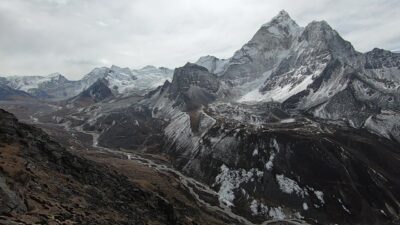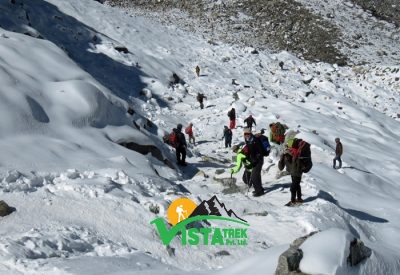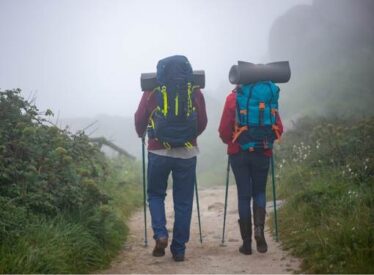The massive Khumbu Glacier is more than just ice and rock; it’s an important part of Earth’s natural history. It is one of the most famous glaciers in the Himalayas, stretching over Nepal’s Everest area. There is so much to learn about this icy monster, from its breathtaking beauty to the obstacles of trekking.
But here’s the thing—many people hear about the Khumbu Glacier, but few actually understand how important and fascinating it really is. Between the cold facts, the breathtaking views, and the climate impact, there are countless reasons why you should care about the Khumbu Glacier Nepal holds so dear.
So, if you’re planning a trek, writing a report, or just curious about glaciers in the Himalayas, you’re in the right place. Let’s dive into the world of the Khumbu Glacier—you’ll leave knowing more than most adults!
The Khumbu Glacier is located in the Everest region of northeastern Nepal. It’s a key feature of Sagarmatha National Park, which is a UNESCO World Heritage Site.

The Khumbu Glacier is not just a pile of ice. It’s a moving river of frozen water, rock, and debris that tells us so much about our planet’s history and future. If you ever trek here, you’ll walk through an icy wonder that’s alive and always changing.
Here are some cool Khumbu Glacier facts that will make your jaw drop:
Knowing these facts makes you appreciate its importance in the natural world. Whether you’re doing the Khumbu Glacier trek or just reading about glaciers in the Himalayas, this one always stands out.
Trekking the Khumbu Glacier is a dream for many adventurers. It’s a big part of the Everest Base Camp route and offers views you’ll remember forever.
Every step on the Khumbu Glacier, Nepal, brings you closer to nature, adventure, and yourself. No wonder it’s a highlight of glaciers in the Himalayas!
The Khumbu Glacier Everest Base Camp connection is legendary. Almost everyone who treks to Everest Base Camp walks along or near the Khumbu Glacier.

So if you’re headed to the Everest Base Camp, you’re also visiting one of the most impressive glaciers in the Himalayas. It’s like stepping into a world of frozen wonder and human courage.
Recommended Packages: Jiri to Everest Base Camp Trek 20 Days
It is just one star in the icy sky of the Himalayas.
Let’s zoom out:
Even among these great giants, the Khumbu Glacier in Nepal is a legend. If glaciers in the Himalayas had a celebrity, it would be this one!
The Khumbu Glacier is in trouble. Like many glaciers in the Himalayas, it’s melting faster than ever.
What’s happening:
So when you hear about climate change, remember the Khumbu Glacier. It’s not just melting ice—it’s melting history and future.
Recommended Read: Seasonal Challenges of Everest Base Camp Trek
Khumbu Glacier isn’t just about nature—it’s also about people and culture.
Khumbu Glacier facts show it’s more than just frozen water. It’s part of a living, breathing world that needs care and respect.
Recommended Read: Festival of Nepal
Planning to go on a Khumbu Glacier trekking adventure? Here’s what you need to know.

To enjoy the beauty of Khumbu Glacier, Nepal, the best seasons are:
When visiting the Khumbu Glacier, being prepared is everything:
You can’t trek to the Khumbu Glacier Nepal without these permits:
Trekking near the Khumbu Glacier is an epic journey, but safety comes first:
The Khumbu Glacier, Nepal experience is truly once-in-a-lifetime. Whether you’re aiming for Khumbu Glacier, Everest Base Camp, or just want to explore one of the most incredible glaciers in the Himalayas, proper planning and gear make all the difference.
Book your Khumbu Glacier trekking adventure with Vista Trek! Let our expert guides lead you through one of the most iconic glaciers in the Himalayas. We handle everything—permits, planning, safety, and more—so you can focus on the journey.
The Khumbu Glacier is a magical mix of nature, adventure, and science. It’s not just a cold place in Nepal—it’s one of the most fascinating glaciers in the Himalayas. The journey is unforgettable, from learning Khumbu Glacier facts to trekking beside its icy paths.
If you’re dreaming of Khumbu Glacier trekking or want to know more, this is the glacier to watch. Let’s protect it, explore it, and never stop being amazed.
Visit Vista Trek today and make your Khumbu Glacier, Nepal dream come true.
The Khumbu Glacier is a huge river of ice in northeastern Nepal, near Mount Everest. It lies in the Khumbu region of Nepal, inside the Sagarmatha National Park, and is part of the famous Everest Base Camp trekking route.
The Khumbu Glacier was formed thousands of years ago from layers of snow that compacted into ice. Over time, gravity pushed this ice downhill between mountains, creating one of the largest glaciers in the Himalayas.
The Khumbu Glacier Everest Base Camp route is a major path for trekkers and climbers. It leads adventurers close to the base of Mount Everest and offers incredible Himalayan scenery.
The Khumbu Glacier Nepal is about 17 kilometers long and can be 1 kilometer wide in some places. It stretches from Everest’s slopes down to the lower Khumbu Valley.
The Khumbu Icefall is a steep and dangerous section at the top of the Khumbu Glacier. Climbers must pass through it when heading from Everest Base Camp to higher camps.
Trekkers face altitude sickness, cold weather, and tricky terrain with rocks and ice. The Khumbu Glacier trekking trail also has crevasses and slippery sections that require care.
Climate change is melting the Khumbu Glacier Nepal faster than ever. This creates glacial lakes and raises the risk of floods. It also makes the trekking path less stable.
The Khumbu Glacier is special because it’s the highest, most visited, and part of the Everest Base Camp route. Unlike other glaciers in the Himalayas, it’s closely tied to adventure and science.
Yes, visiting the Khumbu Glacier Nepal is safe with proper planning. Always trek with a guide, stay hydrated, and move slowly to adjust to the high altitude.